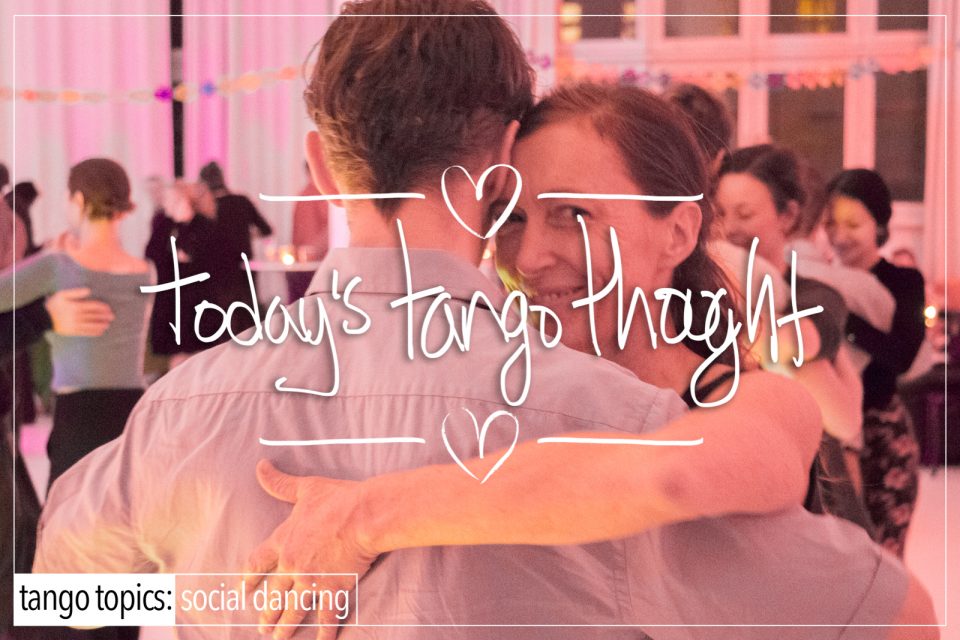The question comes up more often as we are beginners than after we’ve been there for a while. The question ? “How did you start in Tango ?”. It’s usually at this point that we get someone’s ‘story‘ of their entry into Tango. And most of us are keenly interested in hearing these personal details of intrigue, trials, tribulations, virtues, and head shakings that this dance drives us to do. However, in that story that we share with others, we have discovered that there are some commonalities to how people enter the dance. Those commonalities are what has been distilled down to about Five Common Reasons why someone enters Tango. These are the reasons why and not the reasons why someone stays in Tango. Those are very different reasons, but rather why they started dancing in the first place.
It should be noted, that not everyone fits into these 5 categories because they entered the dance through other means. It should also be noted that there are multiple variations on a theme with these ideas. The author ? He started due to a client. The client challenged the author, noting that in the 10 years that the author had been his client, he hadn’t actually tried Tango. At the time the author was a marketing/software consultant, and helping the client to better service his client base. So not going through the pathway of understanding what it was like to be a beginner and go through the process was doing the client a disservice. So the author tried it out. Found that he hated it but stuck around anyway, because it got to him and didn’t want to let Tango beat him. Ultimately the author stayed in the dance for other reasons. Many other reasons!
So without further yappment…these are the FIVE REASONS!
Reason #1: Spouse/Romantic Partner. Usually the Spouse/Romantic Partner has been dragged (hereto referred to the “draggee) by their romantic partner (hereto refereed to as the dragger) into the class. Said ‘draggee’ has absolutely ZERO desire to be there at all! They’d rather have root canal than study Tango. Yet, oddly enough, the draggee ends up staying while the dragger ends up leaving for a variety of reasons: Usually once they realize that there are OTHER people that said draggee will get to dance with. Jealousy rears it’s ugly head! Variation On A Theme: Another variation, which is sort of hard to believe for a wide variety of reasons in this day and age of people doing their own thing even in relationships – The couple that goes to tango willingly together, and surprise, they find that they have something in common that brings them together. While this item sounds like one partner doesn’t want to try tango, and then they do, or it’s variation, where both partners want to try Tango together. The item here is not the dragging partner, nor the couple together. The item is the Spousal/Romantic Partner instead of the Individual wanting to try Tango on their own independent of anyone else! Which is not to disparage a couple trying something out together. It IS to say that this topic is about the ways in which people come to the form. This variation while it may seem common enough is not. The primary is the one that happens more often than not. 🙁
Reason #2: Broken Relationship. This person finds their way to Tango because they’ve recently been left, or they’re going through a divorce. Usually they discover Tango months or a year or so later, this is after they’re able to form sentences again. It should be noted that Tango is not their first choice, truthfully…it’s either Ballroom, Swing, or the more likely…Salsa/Bachata!
Reason #3: Touching/Touched. This one is pretty simple. The reality is that in our modern society, the more that we rely on phones, tablets, and social media, the less physiological contact that we get. We crave touch. Once someone realizes that they can pay their 10.00 to get hugs and to be touched and touch someone else and to hold them close ? And no one is goin* to arrest them for doing it, they’re all in!
Reason #4: Social. There are other social dances and they all have a measure of Social behavior that range from PARTY to Quieter Party. Tango is not a party, but it does have a very active social aspect to it. People that enter through this segment usually stay there. They’re goal isn’t to become better dancers but to have a drink with friends, and to go out dancing. Not to mention it’s also a way to wear all those clothes that they thought they’d never wear. Note this entry method isn’t about the dance. These folks learn just enough to get around the floor to not look like idiots and maybe a little more. They’re not interested in their embrace or what it looks like, they’re interested in hanging out with their friends. The dancing part, is secondary to that experience. There’s also a variation on a theme with this one. Their therapist, ex wife, ex-something, friend, either suggests or drags them to Tango and they end up coming because of the social aspect.
Reason #5: Television/Movies. Someone sees Tango in a Movie, or TV and says to themselves, “I WANT TO DO THAT”. A variation on this one is seeing Tango in a youtube video that a friend posted and falling in love with the bodies moving and projecting what they think they’re seeing. Which might loosely classify as Reason #3, but not.
Honorable Mentions:
Reason #6: Therapist. Their Therapist, Psychoanalyst, social worker friend suggested they try Tango to open them up emotionally. Usually this is seen as a way to crack their emotional shell.
Reason #7: Movement Study. Some people come from another movement form, like Karate, Tai Chi, Aikido, mostly any Martial Art. Someone that is in these forms and is also a Tango dancer immediately suggests one or other as another outlet for to achieve ‘better’. Truthfully the Martial Arts shares a similarity to Tango in more ways than you can shake a stick at. Dressage, Horseback Riding, or even another social dance do as well! If you’ve had any other social dancing background then you have a little bit Tango experience. But that’s where the similarities stop. A Martial Art on the other hand is detailed and precise work, which is why they go hand-in-hand. Ballet, or Yoga practitioners are ideally suited to tango, again for the detailed work.
Reason #8: Another Social Dance. Ballroom, Salsa, or Swing. Usually one of those three forms funnels another dancer into the Tango world. Occasionally it’s Blues, or Kizomba, but usually it’s one of the other 3. In this instance, this person is seeking more social dancing experience. Has seen Tango, and becomes intrigued enough to try it out.
Reason #9: The Music. To be fair, not everyone falls in love with the Music upon first hearing it. The author didn’t that’s for sure. (that changed, obviously, and thankfully). The music, for the most part, is an acquired taste, especially the Golden Age stuff that we actually end up dancing to most of the time. Unfortunately most people’s experience of Tango music (or fortunately depending on your point of view. We view it as an unfortunate) is Late Piazzolla’s musical influence. That combined with modern musical influences such as Gotan Project, NarcoTango, or Tangheto’s music. Usually, or more than likely no one comes into a Tango class knowing or ever having heard Carlos Di Sarli, which usually the first Orchestra that they hear. Usually their first exposure is to what most experienced Tango dancers would think of as completely undanceable later Pugliese musical styles. And if you don’t know your orchestras. Here’s a really good example of what we call “less than desirable” music to dance to > Uuuuugh!
The Tango Topics Opinion: Whatever method that said individual got into Tango, the statistics of them actually staying longer than their first class drops dramatically. Years ago, we did a study on the numbers of how many people actually stayed after their beginner lesson. Of the 1000 people that were invited, 600 showed up. Of the 600 that showed up, 6 stayed for an entire year. Of those 6 that stayed for the year, only 1 is still dancing. What does this tell you ? Either the teaching was really rough, or that 1 in 100 will stay. Both are probably true, either that or the adage that Tango is a difficult dance to learn probably has something to do with it.
Moving along those same lines, it should be noted that 90 to 95% of the people that show up in classes will not stay. The attrition rate is exceptionally high. There are ways to mitigate the fall off but the end result will be the same in the end. However, there are noted exceptions to this phenom. The Teaching Couple that builds community through their classes, this keeps people a bit longer. The Teaching School (DNI, El Corte) that, again, builds Tango Community through exploration of the form. Community seems to be a common theme of getting people into the form, and helping them to stay. However in that environment these people are already committed to the form and have spent a few pennies to be there, so they’re already invested. The Teaching Couple or Tango School (M2 in Copenhagen, Tango Nou or Mala Junta, or Tango Loft in Berlin) invests in building bridges between people, and helps them to build a bigger community base and as a result these people then go out into their communities and start proselytizing the form to their friends. So this is yet another way where someone will enter the dance, and end up staying because of the community of people in the already there.
In the end what gets you in the form is only a story that we tell so that others can understand your motivations for being there. It’s a way to share with others. However, it’s not what keeps you there. That is a whole other story entirely. Occasionally we do need to revisit what brought us to the dance. Whatever life circumstance it was, and re-examine it, refresh it, clarify the story a bit to see if it still holds true. The reason ? Because our reason for still continuing with Tango is partly based on the reason we started in the first place. However as we grow into more ‘seasoned’ dancers we find that there are other reasons for us to stay, and other reasons for us to go. Things change.











